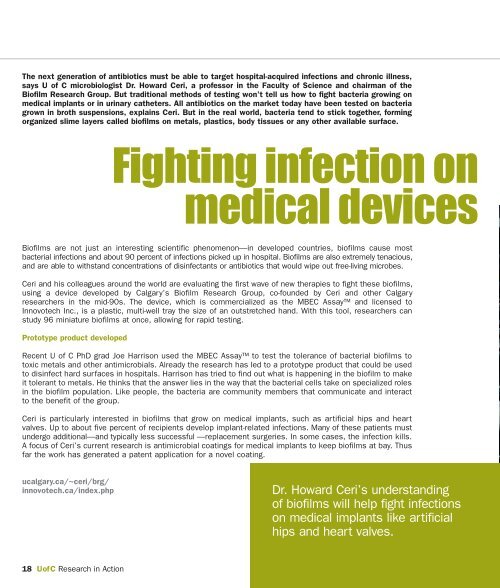Research in Action: - University of Calgary
Research in Action: - University of Calgary
Research in Action: - University of Calgary
You also want an ePaper? Increase the reach of your titles
YUMPU automatically turns print PDFs into web optimized ePapers that Google loves.
The next generation <strong>of</strong> antibiotics must be able to target hospital-acquired <strong>in</strong>fections and chronic illness,<br />
says U <strong>of</strong> C microbiologist Dr. Howard Ceri, a pr<strong>of</strong>essor <strong>in</strong> the Faculty <strong>of</strong> Science and chairman <strong>of</strong> the<br />
Bi<strong>of</strong>ilm <strong>Research</strong> Group. But traditional methods <strong>of</strong> test<strong>in</strong>g won’t tell us how to fight bacteria grow<strong>in</strong>g on<br />
medical implants or <strong>in</strong> ur<strong>in</strong>ary catheters. All antibiotics on the market today have been tested on bacteria<br />
grown <strong>in</strong> broth suspensions, expla<strong>in</strong>s Ceri. But <strong>in</strong> the real world, bacteria tend to stick together, form<strong>in</strong>g<br />
organized slime layers called bi<strong>of</strong>ilms on metals, plastics, body tissues or any other available surface.<br />
Fight<strong>in</strong>g <strong>in</strong>fection on<br />
medical devices<br />
Bi<strong>of</strong>ilms are not just an <strong>in</strong>terest<strong>in</strong>g scientific phenomenon—<strong>in</strong> developed countries, bi<strong>of</strong>ilms cause most<br />
bacterial <strong>in</strong>fections and about 90 percent <strong>of</strong> <strong>in</strong>fections picked up <strong>in</strong> hospital. Bi<strong>of</strong>ilms are also extremely tenacious,<br />
and are able to withstand concentrations <strong>of</strong> dis<strong>in</strong>fectants or antibiotics that would wipe out free-liv<strong>in</strong>g microbes.<br />
Ceri and his colleagues around the world are evaluat<strong>in</strong>g the first wave <strong>of</strong> new therapies to fight these bi<strong>of</strong>ilms,<br />
us<strong>in</strong>g a device developed by <strong>Calgary</strong>’s Bi<strong>of</strong>ilm <strong>Research</strong> Group, co-founded by Ceri and other <strong>Calgary</strong><br />
researchers <strong>in</strong> the mid-90s. The device, which is commercialized as the MBEC Assay and licensed to<br />
Innovotech Inc., is a plastic, multi-well tray the size <strong>of</strong> an outstretched hand. With this tool, researchers can<br />
study 96 m<strong>in</strong>iature bi<strong>of</strong>ilms at once, allow<strong>in</strong>g for rapid test<strong>in</strong>g.<br />
Prototype product developed<br />
Recent U <strong>of</strong> C PhD grad Joe Harrison used the MBEC Assay to test the tolerance <strong>of</strong> bacterial bi<strong>of</strong>ilms to<br />
toxic metals and other antimicrobials. Already the research has led to a prototype product that could be used<br />
to dis<strong>in</strong>fect hard surfaces <strong>in</strong> hospitals. Harrison has tried to f<strong>in</strong>d out what is happen<strong>in</strong>g <strong>in</strong> the bi<strong>of</strong>ilm to make<br />
it tolerant to metals. He th<strong>in</strong>ks that the answer lies <strong>in</strong> the way that the bacterial cells take on specialized roles<br />
<strong>in</strong> the bi<strong>of</strong>ilm population. Like people, the bacteria are community members that communicate and <strong>in</strong>teract<br />
to the benefit <strong>of</strong> the group.<br />
Ceri is particularly <strong>in</strong>terested <strong>in</strong> bi<strong>of</strong>ilms that grow on medical implants, such as artificial hips and heart<br />
valves. Up to about five percent <strong>of</strong> recipients develop implant-related <strong>in</strong>fections. Many <strong>of</strong> these patients must<br />
undergo additional—and typically less successful —replacement surgeries. In some cases, the <strong>in</strong>fection kills.<br />
A focus <strong>of</strong> Ceri’s current research is antimicrobial coat<strong>in</strong>gs for medical implants to keep bi<strong>of</strong>ilms at bay. Thus<br />
far the work has generated a patent application for a novel coat<strong>in</strong>g.<br />
ucalgary.ca/~ceri/brg/<br />
<strong>in</strong>novotech.ca/<strong>in</strong>dex.php<br />
18 U<strong>of</strong>C <strong>Research</strong> <strong>in</strong> <strong>Action</strong><br />
Dr. Howard Ceri’s understand<strong>in</strong>g<br />
<strong>of</strong> bi<strong>of</strong>ilms will help fight <strong>in</strong>fections<br />
on medical implants like artificial<br />
hips and heart valves.

















